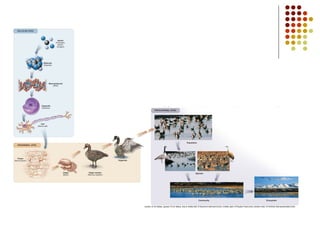Unit1 Lecture1
- 1. BIO 3 Introduction to Biology Instructor: Francisca Herrera
- 2. Course Syllabus Course Requirements Exams Unit Reviews Journals Forums
- 4. What is a living thing? What are the characteristics of life?
- 5. Living organisms are a carbon- and water-based cellular form with complex organization and heritable genetic information. They undergo metabolism, possess a capacity to grow, respond to stimuli, reproduce, and, through natural selection, adapt to their environment in successive generations.
- 6. Properties of life Living organisms are: a carbon- and water-based cellular form Cell Theory Cells are basic structural and physiological units of all living organisms Cells are both distinct entities and building block of more complex organisms
- 7. Properties of life Living organisms: undergo metabolism Require Energy Cells use nutrients to supply energy and build new structures Metabolism: the sum total of chemical reactions that occur in an organism Figure 1.2 Acquiring nutrient material and energy
- 8. Properties of life Living organisms: respond to stimuli Respond helps ensure the survival of an organism allows an organism to carry on daily activities
- 9. Properties of life Living organisms: possess a capacity to grow… reproduce Reproduce and Develop: asexual reproduction (clonal): produce exact replica of themselves sexual reproduction (many strategies): exchange of genetic material between organisms Figure 1.3 A Human Family
- 10. Properties of life Living organisms have: heritable genetic information… through natural selection, adapt to their environment Heredity genome – all DNA molecules in a cell adaptation – an organism’s modification in structure, function, or behavior suitable to the environment
- 11. Properties of life Living organisms have: complex organization Life Science biology is the scientific study of life
- 12. Life is complex! There are levels of life: Figure 1.1 Levels of biological organization Small Molecules Large Molecules Cells Tissues Organs Organ Systems Complex Organisms
- 13. Life is complex! There is diversity of life: Animals Fungi Plants Protists Archaea Bacteria 0 1.0 2.0 3.0 4.0 0.5 1.5 2.5 3.5 Billions of Years Ago (BYA) BACTERI A ARCHAE A EUKA R Y A Figure 1.4 Evolutionary tree
- 14. Figure 1.6 Domain Bacteria Figure 1.5 Domain Archaea Prokaryotes: single-celled organisms
- 15. Eukaryotes: multi-celled organisms Figure 1.8 Kingdom Fungi Figure 1.9 Kingdom Plantae Figure 1.10 Kingdom Animalia Figure 1.7 Kingdom Protista
- 16. Life is complex! There is taxonomic order to life:
- 17. Life is complex! There is ecological order to life:
- 18. Life is complex! Life is interconnected and interdependent: Heat Heat Heat Chemicals Chemicals Decomposers Consumers Producers Solar energy Figure 1.12 A grassland, a terrestrial ecosystem
- 19. The scientific process To understand such a complex subject, scientists developed the scientific method : allows scientists to modify and correct their beliefs as new observations and information becomes available if well supported > theory!
- 20. Core Ideas of Biology A theory is a unifying explanation that has been well supported time and time again. There are four major unifying themes in the study of life.
- 21. Core Ideas of Biology The Cell Theory: All organisms are composed of cells All cells come from other cells Robert Hooke – named cells Anton van Leeuwenhoek – “wee animalcules”
- 22. Core Ideas of Biology The Gene Theory: All organisms have a genome An organism’s genes determine what it will be like (secret code!) James Watson and Francis Crick – discovered DNA structure
- 23. Core Ideas of Biology The Theory of Heredity: The genes of any organism are inherited as discrete units Those genes are packaged up in chromosomes Gregor Mendel – Mendelian segregation
- 24. Core Ideas of Biology The Theory of Evolution: Organisms that can respond to the challenges of living will leave more offspring Descent with modification! Charles Darwin – living organisms are related to one another
- 26. Today’s Journal Entry Under the activities menu of the virtual classroom, click on the Journals link Topic 1 – Introduction to Biology There are no wrong answers in the journal entries. Answer in complete sentences, in a clear and concise manner.
Editor's Notes
- #2: Welcome to the Introduction to Biology course (BIO 003) at Los Angeles Trade Technical College. This is an introductory course dealing with the fundamental properties of living things. Through our virtual classroom, you will have access to unit lectures and online activities. Important course links can be found in the front page of the virtual classroom. A course syllabus has been provided for you that outlines the important information for this course. It is very important for you to review this material and bring up any questions or concerns as soon as possible.

























